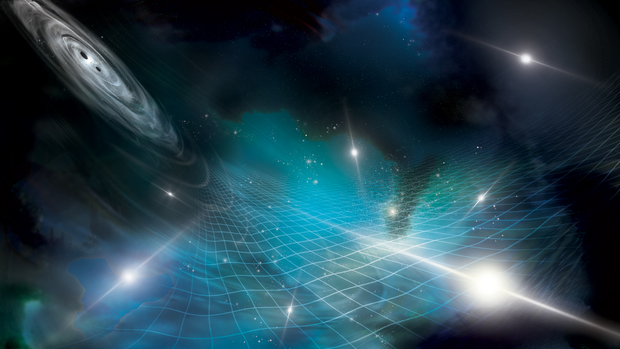
Credit: Aurore Simonnet for the NANOGrav Collaboration
LIGO Congratulates Pulsar Timing Array Teams for New Gravitational Wave Discovery
News Release • June 28, 2023
While LIGO and its partners have detected gravitational waves from sources such as inspiraling pairs of stellar-mass black holes that orbit each other in fractions of a second and generate high-frequency waves up to a few kilohertz, for the last 15+ years, a completely different search for vastly-lower-frequency gravitational waves beyond the reach of LIGO and its partners has also been underway across the globe. Today, the international teams undertaking that search have reported discovering what they believe to be this entirely new class of gravitational waves.
Five teams of pulsar timing array (PTA) groups, the North American Nanohertz Observatory for Gravitational Waves (NANOGrav), the European PTA, the Indian PTA, the Parkes PTA, and the Chinese PTA collectively announced today that they have uncovered "the first evidence for low-frequency gravitational waves permeating the cosmos." These nanohertz gravitational waves, that is, gravitational waves with oscillations of years to decades, may actually be generated by orbiting pairs of supermassive black holes. Supermassive black holes (SMBH), which reside in the hearts of most galaxies, are aptly named as each contains a mass equivalent to billions of Suns. Detecting gravitational waves from such objects suggests that the signals are coming from interacting galaxies whose respective SMBHs are close enough to orbit one another.
In response to this exciting announcement, LIGO Director Dr. David Reitze congratulated the groups involved on behalf of the LIGO Laboratory:
"The LIGO Laboratory congratulates our NANOGrav, European Pulsar Timing Array, Indian Pulsar Timing Array, Parkes Pulsar Timing Array, and Chinese Pulsar Timing Array colleagues on opening the newest gravitational-wave window in the nanohertz frequency region of the spectrum. Their data, collected over more than a decade, for the first time reveals evidence for an incoherent background of gravitational waves produced by the collisions and mergers of supermassive black holes.
Pulsar timing arrays operate in a fundamentally different manner than LIGO, using radio telescopes to precisely time the arrival of pulses emitted from pulsars which allow them to search for gravitational waves with year-long periods. These measurements are beginning to reveal insights into the collisions of galaxies in which supermassive black holes reside, and complement the detections of much lower mass black holes and neutron stars made by LIGO, Virgo, and KAGRA.
Congratulations again to our PTA colleagues!"
For now, interacting supermassive black holes are the leading candidates for the presumed source of the nanohertz waves, but there may be other possible interpretations, as Dr. Michael Lam from NANOGrav explained:
"Right now, we cannot definitively say whether the source of gravitational waves is from supermassive black hole binaries or inflation or cosmic strings or <insert favorite class of sources>, or a mixture of a set of them. From our understanding of the Universe, our prior belief (statistically) is that it is likely from all the SMBH binaries in the Universe, but we can't make that claim from our evidence just yet."
Continued observations will help the groups better understand the full nature of the detected waves.
For complete details on how this exciting discovery was made, please visit each group's website:
Gravitational Wave Frequencies
The frequency of a gravitational wave (GW) is determined by how quickly the interacting objects orbit one another. The gravitational wave frequency is double the orbital frequency, so two small black holes (stellar- or intermediate-mass) orbiting once per second have an orbital frequency of 1 hertz (one orbit completed each second) and would generate a gravitational wave of 2 hertz. Two black holes rapidly orbiting 500 times per second would generate a gravitational wave with frequency of 1000 hertz, or a kilohertz (kHz). LIGO, Virgo, and KAGRA are designed to detect GW in this "higher" range of frequencies.
The frequencies of the GW detected by the pulsar timing array teams are at a far lower end of the frequency scale: nanohertz (nHz). A nanohertz GW is generated by massive objects that take 15 years or more to make one orbit (as opposed to fractions of a second). The only way to detect the gravitational waves from these slow oscillating objects is if they are supermassive, like those residing in the hearts of most galaxies. These are the kinds of waves that the world's pulsar timing array projects are designed to detect.
By Kimberly M Burtnyk, LIGO Laboratory Writer/Editor




